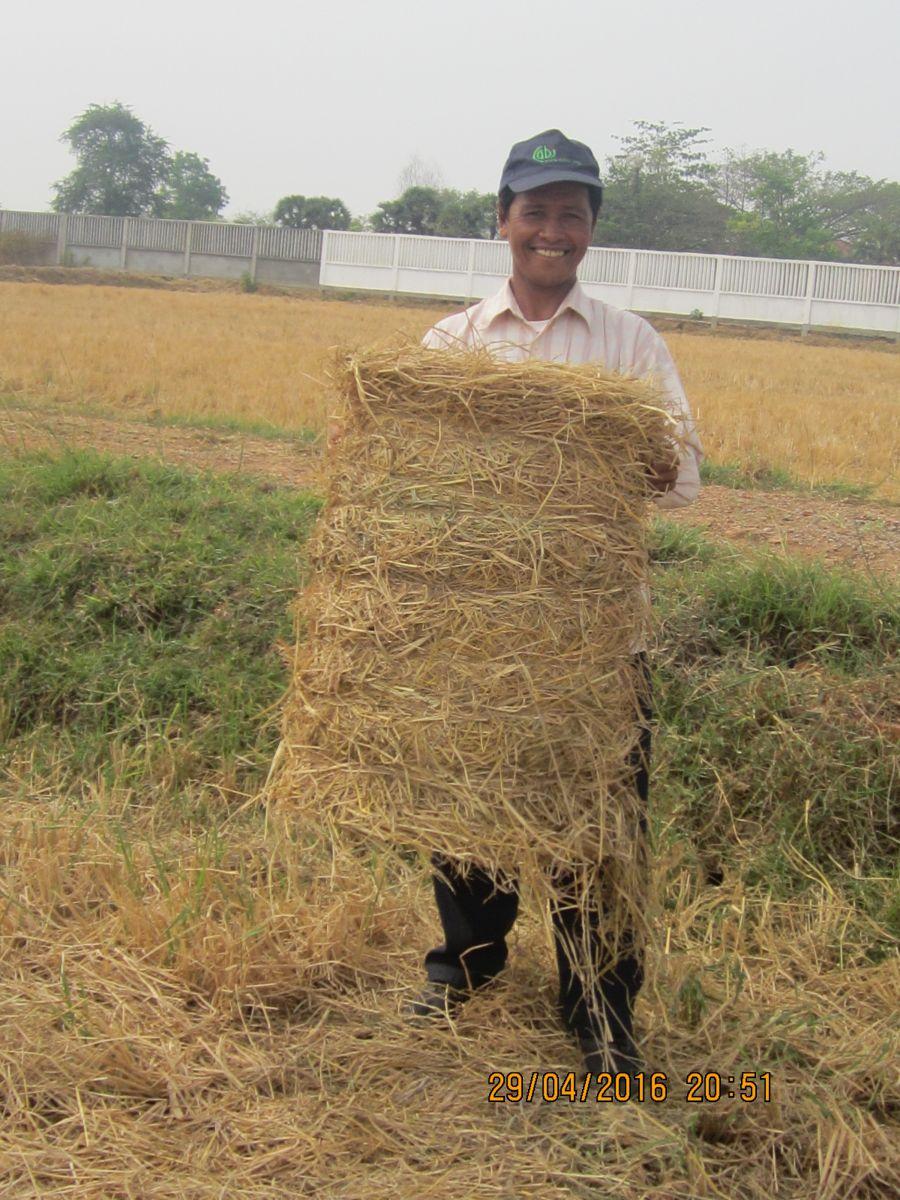Cambodia Climate-Smart Village works to improve rice straw management practices
Farmers from Rohal Suong and members of provincial agricultural departments in Cambodia learn about improving rice straw management practices.
Many rice farmers around the world depend not only on the grains harvested, but also on rice straw for their agricultural production. Available in significant quantities to farmers, rice straw contains a large amount of nitrogen, phosphorous, potassium and sulfur. The majority of these nutrients are wasted when rice straw remains unused, especially when farmers remove or burn the straw from their fields.
Managing rice straw in Cambodia
 |
A farmer from Rohal Suong, who participated in the rice straw management session, holds up a bale of rice straw, at the Don Bosco farm. Many rice farmers depend not only on the grains, but also on rice straw. Photo: Soeung Bora/Aphivat Strey |
In Cambodia, farmers burn a large portion of open-field rice straw, which results in increased greenhouse gas emissions and serious health issues. Open-field rice burning also causes large losses of readily available nutrients for the following crops. Such is the case of the rice farmers in Rohal Suong village in Battambang province of Cambodia. The soil fertility of paddy lands in the village ranges from low to medium, thus farmers often resort to burning rice straw to increase the organic carbon content of their fields. In addition, economic incentive is the main driver behind most farmers’ decision to burn, incorporate or remove straw rice from their fields.
Recent studies, however, show that the most cost-effective option for farmers is to incorporate the rice straw with the soil 30 days before planting the next crop to increase the organic carbon content of their fields. Aside from burning the rice straw, farmers could also use it as fodder for cows, or as mulch for their other crops.
As Rohal Suong is one of the six Climate-Smart Villages (CSVs) under the CGIAR Research Program on Climate Change, Agriculture and Food Security in Southeast Asia (CCAFS SEA), the farmers sought to improve rice straw management. Improved rice straw management, and rice field management in general, is a priority climate-smart agriculture (CSA) practice to be implemented and promoted in the village under the CSV approach.
Learning about improved rice straw management
WorldFish, International Rice Research Institute (IRRI), Don Bosco Centre and the Ministry of Agriculture, Forestry and Fisheries organized an information and discussion session on 30 April 2016 to help Rohal Suong farmers diversify their use of rice straw and improve their rice field management practices. Members of the Pursat and Banteay Meanchey Provincial Departments of Agriculture also attended the session.
During the session the participants went on a field visit to observe rice straw farming machinery and equipment. They were also able to interact and ask other farmers regarding rice straw management. The discussions also touched on the potential benefits of using rice straw as fertilizer, mulch, bio-energy and fodder for livestock. After the field visit, the participants discussed their ideas and opinions on improving rice straw management practices in Cambodia.
The farmers from Rohal Suong are interested in learning in detail how to use a rice straw bailer. They also hope to learn more about the market prices and developments for rice straw in Cambodia. As a whole, the learning session served as a stepping-stone for improving current rice field management practices, including improving pest management and rice straw management in Rohal Suong.
Read more
- Bioenergy takes off as a climate-smart agricultural practice in Vietnam
- Cambodia Climate-Smart Village enhances livelihoods with better water management
- Southeast Asian farmer leaders learn about climate-smart agriculture in Vietnam
Soeung Bora is affiliated with Aphivat Strey, while Fiona Emdin is an intern with WorldFish in Cambodia.



